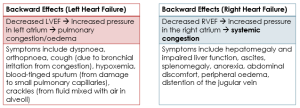3.2 Clinical Presentation(s) of Heart Failure
Signs & Symptoms of Heart Failure
The clinical syndrome of heart failure has typical symptoms; however, they are often not specific. A number of other diagnoses can manifest similarly.
For example, one of the most common symptoms of heart failure is dyspnoea, which can also be associated with respiratory conditions (asthma/COPD) or a pulmonary embolism or an acute coronary syndrome.
Other typical symptoms of heart failure include orthopnoea which is dyspnoea but only when the patient is lying down. Asking the patient how many pillows they use to sleep at night can help to gauge whether orthopnoea is an issue. Patients can find that propping themselves up with pillows can help them to get some relief from pulmonary congestion which some patients say makes them feel like they are drowning.
The clinical presentation of heart failure can vary depending on whether the heart failure is left ventricular failure, right ventricular failure, or biventricular failure. Usually, left ventricular failure happens first. Due to circulatory dynamics, left ventricular failure often leads to right ventricular failure, and so most patients suffer from signs and symptoms of biventricular heart failure.
Left vs Right Sided Heart Failure
When we think about how symptoms differ between left and right sided heart failure, it is important to remember that the left side of the heart receives oxygenated blood from the pulmonary circulation and delivers it to the arteries of the body, whereas the right side of the heart receives deoxygenated blood from the body and pumps it to the lungs so it can be re-oxygenated.

Signs and symptoms of heart failure can be classified as either ‘forward effects’ or ‘backward effects’.
- Forward effects are the direct result of reduced cardiac output.
- Backward effects are the result of congestion of blood behind the ventricle.
Key Takeaways
- LV failure ⇒ reduced tissue perfusion, tiredness, fatigue, confusion, activation of RAAS, increased heart rate, etc.
- RV failure ⇒ reduced output of deoxygenated blood to the pulmonary artery ⇒ reduced delivery of oxygenated blood to the left side of the heart ⇒ reduced tissue perfusion, tiredness, fatigue, confusion, activation of RAAS, increased heart rate, etc.
Key Takeaways

COMMONWEALTH OF AUSTRALIA Copyright Regulations 1969 WARNING
This material has been reproduced and communicated to you by or on behalf of James Cook University in accordance with section 113P of the Copyright Act 1969 (Act).
The material in this communication may be subject to copyright under the Act. Any further reproduction or communication of this material by you may be the subject of copyright protection under the Act. Do not remove this notice.
